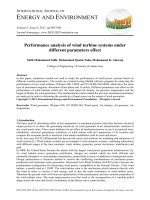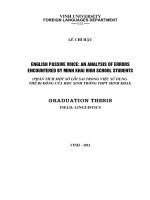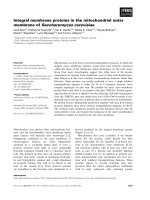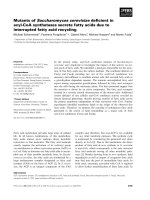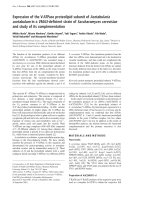Proteomic analysis of saccharomyces cerevisiae KAY446 under very high gravity conditions
Bạn đang xem bản rút gọn của tài liệu. Xem và tải ngay bản đầy đủ của tài liệu tại đây (4.27 MB, 340 trang )
PROTEOMIC ANALYSIS OF
SACCHAROMYCES CEREVISIAE KAY446
UNDER VERY HIGH GRAVITY CONDITIONS
Trong Khoa PHAM (ME)
Thesis submitted for the degree of Doctor of Philosophy (PhD)
to The University of Sheffield, Sheffield, UK
On completion of research in the Biological and Environmental Systems Group within
the Department of Chemical and Process Engineering
May, 2008
This copy of the thesis has been submitted with the condition that anyone who consults it is
understood to recognise that the copyright rests with its author. No quotation and
information derived from this thesis may be published without prior written consent to the
author or the University (as may be appropriate).
i
This thesis is dedicated to my parents, my wife and my daughter.
ii
Declaration
This is to declare that I am the sole author of this thesis with work performed and
completed in The University of Sheffield, UK, except where acknowledgements are made.
This work has not been submitted for any other degrees.
Trong Khoa PHAM (Candidate)
iii
Acknowledgments
I would like to express my sincere appreciations and acknowledgments to all the people
who have been helping me to contribute this thesis. I have really been surrounded by many
nice people!
•
My deepest appreciation to my supervisor Prof. Phillip C. Wright for his excellent
supervision, invaluable guidance, encouragement and inspiration.
•
I would like to express my gratitude to Dr. (Shirly) Poh Kuan Chong, Dr. Chee
Sian Gan for their teaching during the early years of my research, for their
collaborator work, as well as for their endless help when I needed them.
•
I thank Dr. Bram Snijders, and Dr. Martin Barrios-Llerena for their technical
advice. Many thanks to Mark Scaife for his advice and discussions.
•
I would like to acknowledge Prof. Katherine Smart (from Division of Food
Sciences, University of Nottingham) and Dr. Mark Dickman (from Department of
Chemical and Process Engineering, University of Sheffield) for being my external
and internal examiner, as well as a special thanks to Dr. Mark Dickman for his
technical advice.
•
I also gratefully acknowledge the Ministry of Education and Training of Vietnam
for financial support.
•
I thank to Miss Thi Hong Nhan Le who bring a home atmosphere to me and my
family.
iv
•
Last but not least, I would like to thank my family: my parents, Mr Hau Phuc Pham
and Mrs Hoa Thi Trinh who put their hope into my name “Trong Khoa”, for giving
me the life, for educating me, for unconditional support and encouragement. My
wife, Kim-Quyen T. Huynh, for her sacrifice, patience, understanding and
encouragement for all three years. My daughter, Bao-Nhi H. Pham, for her
excellent performance in my spirit.
v
List of Publications
Parts of the work in this thesis have been published as below:
(J – Journal paper, O – Oral presentation, P – Poster presentation)
(J1)
P.K. Chong, C.S. Gan, T.K. Pham, and P.C. Wright, “Isobaric Tag for Relative and
Absolute
Quantitation
(iTRAQ)
reproducibility:
Implication
of
multiple
injections”, Journal of Proteome Research, 5 (5), 2006, 1232-1240.
(J2)
T.K. Pham, P.K. Chong, C.S. Gan, and P.C. Wright, “Proteomic analysis of
Saccharomyces cerevisiae under high gravity fermentation conditions”, Journal of
Proteome Research, 5 (12), 2006, 3411-3419.
(J3)
C.S. Gan, P.K. Chong, T.K. Pham, and P.C. Wright, “Technical, experimental, and
biological variations in Isobaric Tag for Relative and Absolute Quantitation
(iTRAQ)”, Journal of Proteome Research, 6 (2), 2007, 821-827.
(J4)
T.K. Pham and P.C. Wright, “Review: Proteomic analysis of Saccharomyces
cerevisiae”, Expert Review of Proteomics, 2007, 4(6), 793-813.
(J5)
T.K. Pham and P.C. Wright, “Proteomic analysis of calcium alginate immobilized
Saccharomyces cerevisiae under high gravity fermentation condition”, Journal of
Proteome Research, 7 (2), 2008, 515-525.
(J6)
T.K. Pham and P.C. Wright, “The proteomic response of Saccharomyces cerevisiae
in very high glucose conditions with amino acid supplementation”, Journal of
Proteome Research, 7 (11), 2008, 4766-4774.
vi
(J7)
T.K. Pham and P.C. Wright, “Proteomic analysis of Saccharomyces cerevisiae
during continuous fermentation under VHG conditions: Regulation of proteomics
versus oscillation of fermentation process”, In preparation.
(J8)
T.K. Pham and V.M. Le-Van, “Fermentation for ethanol production using
immobilized yeast cells in alginate gel” Proceeding of the 8th ASEAN Food
Conference, Nov 2003, Hanoi-Vietnam.
(J9)
T.K. Pham and V. M. Le-Van, “Using Saccharomyces cerevisiae immobilized in
calcium alginate gel for ethanol fermentation”, Proceeding of the 8th Conference on
Science and Technology, Apr 2002, HoChiMinh-Vietnam.
(O1)
P.K. Chong, C.S. Gan, T.K. Pham and P.C. Wright, “Application and reliability of
isobaric mass tagging technology in proteomics”, 232nd ACS National Meating,
San Francisco, CA, Sep 10-14th, 2006.
(O2)
P.K. Chong, C.G. Gan, T.K. Pham and P.C. Wright, “Assessing iTRAQ’s reliability,
quantitative proteomics, Applications in Biology and Medicine, Sheffield, Oct
2006.
(P1) T.K. Pham and P.C. Wright, “Proteomic analysis of Saccharomyces cerevisiae under
high gravity conditions”, 3rd Joint BSPR/EBI Meeting, Cambridge, UK, Jul 12-14th,
2006.
vii
Table of Contents
Declaration............................................................................................................................ iii
Acknowledgments ................................................................................................................ iv
List of publications ............................................................................................................... vi
Table of contents................................................................................................................. viii
List of tables........................................................................................................................ xiv
List of figures...................................................................................................................... xvi
Abbreviations..................................................................................................................... xxii
Abstract.............................................................................................................................. xxv
Chapter 1 ............................................................................................................................ 26
1.1. Introduction ......................................................................................................... 27
1.2. Aims of this thesis ............................................................................................... 28
1.3. Thesis overview................................................................................................... 28
Chapter 2 ............................................................................................................................ 31
2.1. Abstract................................................................................................................ 32
2.2. Literature review of Saccharomyces cerevisiae proteomic analysis ................... 32
2.2.1.
The importance of proteomic investigations in Saccharomyces cerevisiae...
................................................................................................................... 32
2.2.2.
Proteomics as a tool for the identification and quantitation of S. cerevisiae
proteins ...................................................................................................... 34
2.2.3.
The identification and quantitation of S. cerevisiae proteins in proteomics
experiments................................................................................................ 43
2.2.4.
Proteomics in the study of S. cerevisiae networks..................................... 57
2.2.5.
Proteomic analysis of S. cerevisiae protein modifications ........................ 62
2.2.6.
Discussion.................................................................................................. 65
viii
2.2.7.
The outlook of S. cerevisiae proteomics analysis ...................................... 68
2.3. Bioethanol fermentation process and methods to improve this process .............. 71
2.3.1.
Bioethanol fermentation process ............................................................... 71
2.3.2.
Methods (techniques) to improve bioethanol fermentation ....................... 78
Chapter 3 ............................................................................................................................ 82
3.1. Abstract................................................................................................................ 83
3.2. Introduction ......................................................................................................... 83
3.3. Materials and Methods ........................................................................................ 85
3.3.1.
Sample preparation .................................................................................... 85
3.3.2.
Protein preparation..................................................................................... 86
3.3.3.
Experimental design .................................................................................. 86
3.3.4.
Isobaric peptide labeling............................................................................ 87
3.3.5.
Strong cation exchange fractionation......................................................... 88
3.3.6.
Mass spectrometric analysis ...................................................................... 88
3.3.7.
Data analysis .............................................................................................. 89
3.4. Results and discussion ......................................................................................... 90
3.4.1.
Multiple injections ..................................................................................... 90
3.4.2.
Technical variation .................................................................................... 97
3.5. Conclusions ......................................................................................................... 99
Chapter 4 .......................................................................................................................... 100
4.1. Abstract.............................................................................................................. 101
4.2. Introduction ....................................................................................................... 101
4.3. Materials and methods....................................................................................... 104
4.3.1.
Fermentation conditions .......................................................................... 104
4.3.2.
Measurements of fermentation parameters.............................................. 105
4.3.3.
Cell extraction, labeling, mass spectrometry and data analysis............... 105
4.4. Results and discussion ....................................................................................... 106
4.4.1.
Ethanol fermentation as a function of glucose concentration .................. 106
ix
4.4.2.
Relative protein expression under different glucose concentrations ....... 108
4.4.3.
The glycolysis pathway ........................................................................... 110
4.4.4.
Storage carbohydrates.............................................................................. 114
4.4.5.
The requirement for redox balance led to secondary products generation
................................................................................................................. 115
4.4.6.
Tricarboxylic acid cycle (TCA cycle)...................................................... 118
4.4.7.
Amino acids metabolism ......................................................................... 118
4.4.8.
Proteins involved in eIF (eukaryotic initiation factor), and heat-shock
proteins .................................................................................................... 120
4.5. Conclusions ....................................................................................................... 123
Chapter 5 .......................................................................................................................... 125
5.1. Abstract.............................................................................................................. 126
5.2. Introduction ....................................................................................................... 126
5.3. Materials and methods....................................................................................... 129
5.3.1.
Growth conditions.................................................................................... 129
5.3.2.
Measurements of fermentation parameters.............................................. 130
5.3.3.
Cell viability determination ..................................................................... 130
5.3.4.
Dry weight determination ........................................................................ 130
5.3.5.
Glycogen and trehalose determination..................................................... 130
5.3.6.
Intracellular amino acids determination................................................... 131
5.3.7.
Labeling, mass spectrometry and data analysis ....................................... 132
5.4. Results and discussion ....................................................................................... 133
5.4.1.
The cell growth during lag phase under stress condition......................... 133
5.4.2.
The fluctuations in intracellular amino acids concentrations................... 134
5.4.3.
The identification and classification of detected proteins........................ 142
5.4.4.
The expression of proteins related to the biosynthesis of amino acids .... 149
5.4.5.
Response of heat-shock proteins to VHG conditions with amino acid
supplementation ....................................................................................... 152
x
5.4.6.
The expression of proteins related to translation processes (aminoacyltRNA biosynthesis) and yeast growth...................................................... 155
5.4.7.
The expression of proteins related to cell division, cycle, and homeostasis
................................................................................................................. 156
5.4.8.
The expression of proteins related to the stress condition, trehalose and
glycogen biosynthesis .............................................................................. 157
5.4.9.
The expression of proteins related to ethanol fermentation..................... 159
5.4.10.
The expression of proteins relating to energy metabolism and nucleotide
metabolism............................................................................................... 161
5.4.11.
Comparison of ethanol fermentation process .......................................... 161
5.5. Conclusions ....................................................................................................... 162
Chapter 6 .......................................................................................................................... 164
6.1. Abstract.............................................................................................................. 165
6.2. Introduction ....................................................................................................... 165
6.3. Materials and methods....................................................................................... 168
6.3.1.
Cell growth conditions and immobilization............................................. 168
6.3.2.
Measurement of fermentation parameters ............................................... 169
6.3.3.
Immobilized cell extraction ..................................................................... 170
6.3.4.
Labeling, mass spectrometry and data analysis ....................................... 170
6.4. Results and discussion ....................................................................................... 171
6.4.1.
The behaviour of immobilized cells, and the kinetic fermentation
parameters................................................................................................ 171
6.4.2.
The identification and quantitation of protein expression ....................... 177
6.4.3.
The Ras/cAMP pathway .......................................................................... 178
6.4.4.
The glycolysis pathway ........................................................................... 180
6.4.5.
Utilization of ATP, and the synthesis of trehalose and glycogen ............ 182
6.4.6.
Differential expression of ribosomal proteins.......................................... 185
6.4.7.
Proteins essential for viability.................................................................. 186
xi
6.4.8.
Proteins related to de novo biosynthesis of amino acids and aminoacyltRNA biosynthesis ................................................................................... 187
6.4.9.
Heat-shock proteins ................................................................................. 188
6.4.10.
Comparison of ethanol fermentation processes ....................................... 189
6.5. Conclusions ....................................................................................................... 190
Chapter 7 .......................................................................................................................... 192
7.1. Abstract.............................................................................................................. 193
7.2. Introduction ....................................................................................................... 193
7.3. Materials and methods....................................................................................... 196
7.3.1.
Fermentation system ................................................................................ 196
7.3.2.
Cell growth conditions, immobilization, measurements of fermentation
parameters, and proteomic analysis ......................................................... 197
7.3.3.
ATP and ADP measurements .................................................................. 198
7.3.4.
Ethanol yield determination..................................................................... 198
7.4. Results and discussion ....................................................................................... 199
7.4.1.
The fluctuation of parameters .................................................................. 199
7.4.2.
Ethanol yield oscillations......................................................................... 204
7.4.3.
The rhythm of oscillations ....................................................................... 205
7.4.4.
Expression of proteins in generating the rhythm of the oscillations........ 206
7.4.5.
Comparison of ethanol fermentation process .......................................... 221
7.5. Conclusions ....................................................................................................... 223
Chapter 8 .......................................................................................................................... 225
8.1. Conclusions ....................................................................................................... 226
8.2. Recommendations ............................................................................................. 230
References ........................................................................................................................ 236
xii
Appendices ....................................................................................................................... 289
Appendix A ....................................................................................................................... 290
Appendix B ....................................................................................................................... 291
Appendix C ....................................................................................................................... 292
Appendix D ....................................................................................................................... 301
Appendix E ....................................................................................................................... 310
Appendix F ....................................................................................................................... 317
Appendix G ....................................................................................................................... 328
Appendix H ....................................................................................................................... 333
xiii
List of Tables
Table 2.1. An introduction and comparison of methods for quantitation. .......................... 38
Table 3.1. Summary of iTRAQ labeled samples for all three organisms studied. .............. 87
Table 3.2. The protein distribution for both the mixed genome and single genome database.
Here, alien proteins were referred to those false identifications identified in the database,
but do not belong to the respective model of organism. The ‘Overlapping proteins’ are
defined as the proteins being found in both databases (mixed genome and single genome)
and ‘Non-overlapping proteins’ were those proteins identified only in either one database.
............................................................................................................................................. 91
Table 3.3. Total unique peptides identified in mixed genome from replicate analyses for all
the organisms. Here, only the proteins identified for the corresponding organism were taken
into account (excluding alien proteins)................................................................................ 92
Table 3.4. The coefficient of variation (CV) calculated for the 10 experiments carried out.
Only proteins found repeatedly in all three injections were taken into account in the CV
calculation to investigate the MS and iTRAQ variance in this study .................................. 96
Table 3.5. The percentage of variation obtained from technical replicates in iTRAQ
experiments .......................................................................................................................... 97
Table 5.1. The list of amino acids detected by GC-MS. ................................................... 135
Table 5.2. Relative expression levels of proteins discussed here...................................... 143
Table 6.1. The fermentation kinetic parameters using free and immobilized cells with
various media. .................................................................................................................... 174
Table 7.1. The fluctuations of ethanol, glycerol, and residual glucose concentrations, as
well as biomass in the bioreactor during continuous fermentation under VHG conditions
with different dilution rates................................................................................................ 200
xiv
Table 7.2. The fluctuations of ethanol, glycerol, and residual glucose concentrations, as
well as biomass in the column during continuous fermentation under VHG conditions with
different dilution rates........................................................................................................ 201
Table 7.3. The fluctuations of ethanol yields corresponding to three different dilution rates.
........................................................................................................................................... 204
Table 7.4. Concentrations of ATP and ADP, and ratio of ATP/ADP versus times. ......... 209
xv
List of Figures
Figure 1.1. The diagram illustrates the relationship between chapters in this thesis. ......... 30
Figure 2.1. The relationship of DNA, RNA, and protein in terms of “-omics”. The Figure
also illustrates the main functions of proteomics in the study of S. cerevisiae.................... 33
Figure 2.2. The identification and quantitation methods which have been applied to the
proteomic analysis of S. cerevisiae. ..................................................................................... 35
Figure 2.3. An overview of the workflows involved in the various labeling methods. ...... 36
Figure 2.4. Structure of reagents used for iTRAQ (A) or ICAT (B) techniques................. 42
Figure 2.5. The combination of nano-LC-MS/MS (A) or MALDI-MS (B). ...................... 44
Figure 2.6. Illustration of the total ion intensity (A), the mass spectrum of isolated peptide
determined by MS (B), the figure inset illustrates the mass-to-charge values around the ion
peptide of interest (see the text for details), and the fragments of the selected peptide (C). ...
............................................................................................................................................. 46
Figure 2.7. The fragmentation of protonated peptide ions, and correlated ions that can be
formed in tandem MS/MS. .................................................................................................. 47
Figure 2.8. Illustration of the matching of mass spectra data with protein (peptide)
database. While (A) is used for MALDI-TOF instrument, (B) for LC-MS/MS instrument....
............................................................................................................................................. 28
Figure 2.9. Illustration of algorithm searching for peptide (protein) identification. ........... 50
Figure 2.10. Number of publications related to the proteomic analysis of S. cerevisiae. ... 51
Figure 2.11. The reconstruction of central carbon metabolism in relationship to the TCA
cycle, starch and sucrose metabolism, and the biosynthesis of amino acids. ...................... 59
Figure 2.12. The glycolysis pathway for ethanol and glycerol production......................... 72
Figure 3.1. (A) The overall percentage increment in the total number of unique proteins,
unique peptides and spectra identified from the mixed genome database (excluding alien
proteins) for each iTRAQ experiments via three analyses. The overall increment was
xvi
calculated based on the result obtained from all three injections compared to the result
obtained in first injection. (B) The average percentage increment in total number unique
proteins, unique peptides and spectra identified in (i) two analyses, which was calculated by
comparing the result obtained from two injections (1st and 2nd injection) to the first
injection; and (ii) three analyses, the comparison between the result obtained in all the three
injections to the total result obtained from the first two injections (1st and 2nd injection). .. 94
Figure 3.2. The average percentage of coverage at different levels for technical replicates.
A total of 5 replicates were used with 1 set from S. cerevisiae, and 2 each from
Synechocystis sp. and S. solfataricus, respectively .............................................................. 98
Figure 4.1. The factors that can inhibit yeast cells............................................................ 102
Figure 4.2. Residual glucose, ethanol, and glycerol concentrations, as well as the growth of
S. cerevisiae in the broths under different glucose concentrations: 120 g/L (U), 210 g/L
( ), and 300 g/L ({). Filled symbols are representative for (A) OD650, or (B) glycerol,
open symbols are representative for (A) glucose, or (B) ethanol. Experiments were
performed in triplicate........................................................................................................ 107
Figure 4.3. The number of protein showing either up- or down-regulation with respect to
their functional groups involved in primary and secondary metabolic pathways.............. 109
Figure 4.4. Relative protein expression levels of glycolysis related proteins in the 210 g/L
and 300 g/L glucose conditions compared to the 120 g/L glucose concentration. ............ 109
Figure 4.5. The glycolysis pathway shown in relationship to other metabolic pathways,
such as the citrate cycle; alanine and aspartate metabolism; glutamate metabolism; lysine
biosynthesis; phenylalanine, tyrosine and tryptophan biosynthesis; and starch and sucrose
metabolism (with reference to KEGG). Proteins shown in bold format with blue
background and ratio in red is representative for up (+) regulation; proteins in bold format
with green background and ratio in blue is representative for down (-) regulation in this
study. The expression ratios of these proteins are also shown in Table 1 in Appendix C. ......
........................................................................................................................................... 111
Figure 4.6. The central model of redox balance, and bioenergetics in glycolysis. ........... 117
xvii
Figure 4.7. Relative protein expression levels of heat-shock proteins in the 210 g/L and 300
g/L glucose conditions compared to the 120 g/L glucose concentration. .......................... 121
Figure 5.1. The growth of S. cerevisiae under standard conditions (20 g/L of glucose)
(control samples) without ( ) or with () a dilution of OD650 (see the text for details), and
VHG conditions (300 g/L of glucose) without ({) with (z) amino acid supplementation.
All experiments were performed in triplicate. The numbers in the dashed boxes indicate
sampling times for iTRAQ proteomic analysis.................................................................. 134
Figure 5.2. The ion chromatograph of a synthetic amino acid mixture analysed by GC/MS.
The details of compound-specific ions are displayed in Table 5.1, as well as the peptide
codes are also shown in Table 5.1. The inserted Figure illustrates the peak area was used to
calculate the peptide concentration. ................................................................................... 136
Figure 5.3. The concentrations of intracellular amino acids in cells grown with standard
( ) and VHG conditions with (z) or without ({) amino acid supplementation. All
experiments were performed in triplicate .......................................................................... 137
Figure 5.4. The expression of proteins at 2, 10, and 12 h under VHG conditions with amino
acid supplementation compared to standard conditions (at 0 h). Red, green and yellow
colours are representatives for numbers of down-, up-, un- regulated proteins, respectively.
........................................................................................................................................... 148
Figure 5.5. The relationship of most amino acid metabolisms in relationship with proteins
detected here (modified from [309]).................................................................................. 151
Figure 5.6. A representation of the response of yeast to osmotic stress. Bold arrows are
representative for flux of molecules (such as water, ions, trehalose, glycogen), as well as
physical forces (such as turgor pressure). Dashed and plain arrows are representative for
putative pathways, interactions, chains of events that may be triggered, enhanced (+) or
negatively affected (-) by osmotic stress............................................................................ 154
Figure 5.7. Concentrations of trehalose ({) and glycogen ( ) before (at 0 h) and after (2,
10 and 12 h) stress conditions were applied. ..................................................................... 159
xviii
Figure 6.1. Numbers of cells during fermentations. All experiments were performed in
triplicate. ............................................................................................................................ 172
Figure 6.2. Residual glucose concentrations in the broths with free cells (U) and
immobilized cells without (c) or with ( ) an amino acid supplementation. Experiments
were performed in triplicate.
Figure inset illustrates the fluctuation of the glucose
concentration in the broths during the early hours of fermentation. .................................. 173
Figure 6.3. (A) Concentrations of ethanol (open symbols), and (B) glycerol (filled
symbols) in the broths with free cells (U) and immobilized cells under conditions of
without (c) or with ( ) an amino acid supplementation. Experiments were performed in
triplicate. ............................................................................................................................ 173
Figure 6.4. Dependency of reaction rates on glucose concentration. (U) free cells, (c) and
( ) are immobilized cells without, or with an amino acids supplement respectively....... 175
Figure 6.5. A Hill plot representing the activity of a particular key enzyme in free cells and
immobilized cells. (U) represents free cells, while (c) and ( ) represent immobilized cells
without or with an amino acid supplementation respectively............................................ 176
Figure 6.6. The expression of proteins in immobilized cells compared to free cells (c), and
immobilized cells with an amino acid supplementation compared to free cells ( ). All data
are presented in log10 space................................................................................................ 177
Figure 6.7. The glycolysis pathway is depicted in relationship to the Ras/cAMP pathway,
starch and sucrose pathway, amino acid biosynthesis, and aminoacyl t-RNA biosynthesis.
Metabolites are shown with a blue background (except for energy compounds in red), while
up-regulated proteins are depicted with a green background. The blue line shows the
interaction of transmission of signals to activities of proteins........................................... 179
Figure 6.8. A model to describe the activation of Ras/cAMP pathway for the transition of
signals in immobilized cells compared to freely suspended cells. Its activation indirectly
accelerated alcohol fermentation under the conditions studied here.................................. 183
xix
Figure 6.9. Concentrations of trehalose (A) and glycogen (B) at the 48th and 60th h
sampling time for iTRAQ experiment ( free cells, immobilized cells, immobilized cells
with an amino acid supplementation). All experiments were performed in triplicate. ...... 184
Figure 7.1. The system consisting of a stirrer bioreactor, and a column bioreactor was used
for continuous fermentation under VHG conditions. 1 and 5 – Media and broth bottles, 2 –
Peristaltic pumps, 3– Stirred bioreactor 4 – Column bioreactor, 6 – Valves, 7 – Computer
and controller. .................................................................................................................... 197
Figure 7.2. The concentrations of ethanol (), glycerol ({), and residual glucose (¡) as
well as biomass (z) for continuous fermentation under VHG conditions at a dilution rate of
D1 = 0.020 h-1. (A) is representative for the stirred bioreactor, and (B) for the column
bioreactor. .......................................................................................................................... 199
Figure 7.3. The concentrations of ethanol (), glycerol ({), and residual glucose (¡) as
well as biomass (z) for continuous fermentation under VHG condition at dilution rate D2 =
0.025 h-1. (A) is representative for the bioreactor, and (B) for the column........................ 199
Figure 7.4. The concentrations of ethanol (), glycerol ({), and residual glucose (¡) as
well as biomass (z) for continuous fermentation under VHG condition at dilution rate D3 =
0.030 h-1. (A) is representative for the bioreactor, and (B) for the column........................ 200
Figure 7.5. The regulation of proteins relating to the fluxes of glycolysis (A), F-ATPases
and V-ATPases (B), and other proteins (C) at the sampling time of 132 h, 144 h, and 165 h
compared to 120 h.............................................................................................................. 208
Figure 7.6. The figure is reproduced from Figure 7.3.A to illustrate the sampling times as
well as the labeling samples for proteomic analysis. The concentrations of ethanol (),
glycerol ({), and residual glucose (¡) as well as biomass (z) for continuous fermentation
under VHG condition at dilution rate D2 = 0.025 h-1......................................................... 210
Figure 7.7. The regulation of pO2 in the bioreactor........................................................... 210
Figure 7.8. The diagram illustrates the formation and consumption of ATP, ADP, NAD+,
NADH in glycolysis and other pathways. The effects of metabolites on activity of proteins
functioned in the regulator of glycolytic flux are also included. The green dotted line is
xx
representative for the activation of a metabolite on the protein activity, and red dotted line
is for the de-activation of a metabolite on the protein activity. ......................................... 213
Figure 7.9. The structures of F- and V-ATPases in the relationship with proteins detected
in this study. The Figure was modified from [444, 445]. For F-ATPase, the synthesis of
ATP occurs in F1 coupling with the transport of proton through F0 from lumen/extracellular.
For the For V-ATPase, the V1 domain is response for ATP hydrolysis and drives proton
transport through the V0 domain from cytoplasm.............................................................. 216
Figure 7.10. The summarization of continuous fermentation fluctuation. Data were taken
from duplicate fermentation experiments. ......................................................................... 221
xxi
Abbreviations
1-DE: One dimensional gel electrophoresis
2-DE: Two dimensional gel electrophoresis
ACN: Acetonitrile
ADP: Adenosine diphosphate
AMP: Adenosine monophosphate
ATP: Adenosine triphosphate
cAMP: Cyclic adenosine monophosphate
CPY: Carboxypeptidase Y
CV: Coefficient of variation
D: Dilution rate
DIGE: Difference gel electrophoresis
DNA: Deoxyribonucleic acid
DTT: Dithiothreitol
ECD: Electron capture dissociation
EDC: 1-(3-dimethylaminopropyl)-3-ethylcarbodiimide hydrochloride
EDTA: Ethylenedinitrilotetraacetic acid
EF: Error factor
eIF: Eukaryotic initiation factor
ESI: Electrospray ionization
ETD: Electron transfer dissociation
FDA: Food and drug administration
FT-ICR: Fourier transform ion cyclotron resonance
GDP: Guanosine diphosphate
GEF: Guanine nucleotide-exchange factor
GRAS: Generally regarded as safe
xxii
GTP: Guanosine triphosphate
HOG-MAP: High osmolarity glycerol response – Mitogen actived protein
HPLC: High-performance liquid chromatography
HSP: Heat-shock protein
ICAT: Isotope-coded affinity tags
iTRAQ: Isotope tags for relative and absolute quantification
KEGG: Kyoto encyclopedia of genes and genomes
LC: Liquid chramatography
m/z: Mass-to-charge ratio
MALDI: Matrix-assisted laser-desorption ionization
MBDSTFA: N-methyl-N-t-butyldimethylsilyl-triflouroacetamide
MCAT: Mass-coded abundance tagging
MES: 2-Morpholinoethanesulfonic acid
MFA: Metabolic Flux Analysis
mRNA: Messenger ribonucleic acid
MS/MS: Tandam mass spectrometry
MS: Mass spectrometry
NAD+ (NADH): Nicotinamide adenine dinucleotide
NADH: Nicotinamide adenine dinucleotide
NCBI: National center for biotechnology information
OD: Optical density
PAGE: Polyacrylamide gel electrophoresis
PTM: Post-translational modification
RNA: Ribonucleic acid
RP: Reverse phase
SCX: Strong cation exchange
SILAC: Stable isotope labeling of amino acids in culture
TAP: Tandem affinity purification
xxiii
tBOC: Tert-butoxycarbonyl
TCA: Tricarboxylic acid cycle
TEAB: Tetraethylammonium borohydride
TFA: Trifluoroacetic acid
TOF: Time of flight
tRNA: Transport ribonucleic acid
VHG: Very high gravity
xxiv
Abstract
Enhanced ethanol fermentation is one of the current issues in fermentation technology; this
also is a main aim that goes through this thesis. In this thesis, S. cerevisiae KAY446 was
used for ethanol fermentation under very high gravity (VHG) conditions. This strain
showed an ability to ferment under these conditions since an average ethanol concentration
of 117.5 g/L was determined for continuous fermentation. In terms of deeper biological
aspects, a proteomic analysis of S. cerevisiae was also performed to gain an understanding
of this micro-organism in responding to stress conditions due to high glucose
concentrations in the broths. Therefore, the iTRAQ technique was used as a proteomics tool
for this purpose. The reliability of this technique was analysed via three different domains
of life, including S. cerevisiae (eukaryotes), S. solfataricus (archaea) and Synechocystis sp.
(bacteria). Based on multiple replicate analyses, an increment of peptides (proteins) was
found, as well as a technical replicate to confirm the reliability of this method. The main
functions of the proteomic analyses in this thesis were to discover three crucial objectives:
firstly, to investigate the cellular response of S. cerevisiae to osmotic stress generated by
VHG conditions, as well as to immobilization of cells; secondly, to examine the response of
this micro-organism to VHG conditions with an amino acid supplementation; and finally, to
investigate the main triggers for the fluctuation of fermentation parameters observed during
continuous fermentation process.
xxv

